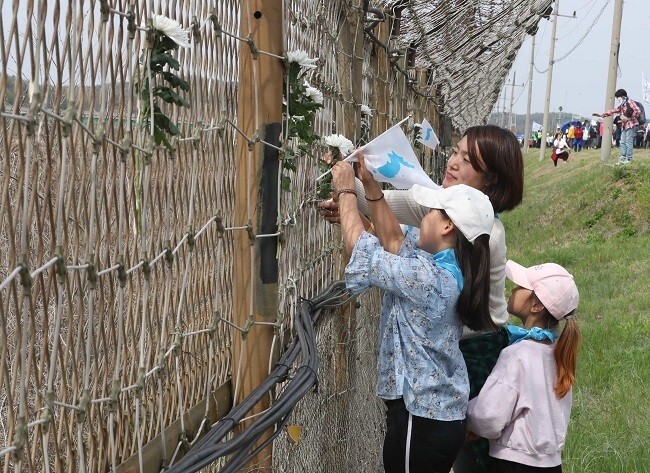hankyoreh
Links to other country sites 다른 나라 사이트 링크
Converting a Cold War remnant into a symbol of peace and reconciliation

A little over 3km from Imjingak in Paju over the Unification Bridge is the site of Camp Greaves, a former US Forces Korea (USFK) base. Situated in the low northern foothills over the Imjin River between the Bridge of Freedom and the Unification Bridge, its rooftops are almost visible from atop the trusses at the Imjingak Observatory.
One of two USFK bases located within the Civilian Control Line (CCL) -- the other being Camp Bonifas, which is used to house UN forces at the Joint Security Area (JSA) -- Camp Greaves bears witness to the scars of the Korean Peninsula’s division.
Located just 2km from the DMZ’s Southern Limit Line (SLL), Camp Greaves was used by USFK for over 50 years after the Korean Armistice Agreement was signed in 1953. Its well-preserved facilities are seen to have great historical value. Built in low-slung semicircles, the corrugated iron Quonset huts used early on by the US forces for barracks and company headquarters seem like something that might appear in an old movie. While some Quonset huts can be found in other locations, this is the only one where their interiors remain preserved in their original state.
The accommodations used for officers and noncoms give the impression of having been made a bit fancier and more convenient than the temporary Quonset structures. Other US military facilities that remain attractively preserved include the armory used to store live ammunition and mortars, the automobile repair garage, and a gym with exercise equipment.
A setting that bears the anguish of division lasting for a half-century, Camp Greaves was used solely for security education in the past. Now, it is ringing out with a message of peace and coexistence.
Camp Greaves was originally scheduled for demolition in 2004 following the withdrawal of the 1st Battalion of the 506th US Second Infantry Division. In 2013, it was taken over by Gyeonggi Province and Paju and Gyeonggi tourism corporations, which have been remodeling it into a “peace, security, and ecology experience center” reflecting Korea’s divided nation status -- assigning it a “role in turning the scars of the DMZ into new life and hope.”
Camp Greaves’ transformation into a “DMZ experience center” began with the renovation of a relatively modern concrete barracks structure into a youth hostel -- the only “experience-type accommodations” present within the CCL. The Quonset barracks and officer/noncom accommodations were presented as exhibits with themes including “division”; the gymnasium has been used for performances. The transformation was completed last year with the creation of a walking trail around the unit with a double barbed-wire fence, designed to resemble the boundary on the front lines.
With the 3rd Tunnel, the Dorasan Observatory, Dorasan Station, Dorasan Peace Park, and the Unification Village located nearby, the DMZ experience center at Camp Graves affords an environment that addresses issues of peace and reunification along with its security experience. Another message concerning peace comes through a culture and arts project involving the work of young artists, which can be viewed inside US barracks and magazine structures dating back to the 1950s.
According to Gyeonggi Province, a total of 10,864 people visited Camp Greaves between January and June 2019, representing a 30.6% increase from 8,321 over the same period last year. In the first half of 2018, the 325 foreign visitors represented just 3.9% of the total; this year, foreign visitors numbered 2,161, or around 20%. While 60% of visitors last year were Gyeonggi residents, the percentage from regions outside of Gyeonggi rose to 55% this year.
By Kim Hak-jun, senior staff writer
Please direct comments or questions to [english@hani.co.kr]

Editorial・opinion
![[Column] Park Geun-hye déjà vu in Yoon Suk-yeol [Column] Park Geun-hye déjà vu in Yoon Suk-yeol](https://flexible.img.hani.co.kr/flexible/normal/500/300/imgdb/original/2024/0424/651713945113788.jpg) [Column] Park Geun-hye déjà vu in Yoon Suk-yeol
[Column] Park Geun-hye déjà vu in Yoon Suk-yeol![[Editorial] New weight of N. Korea’s nuclear threats makes dialogue all the more urgent [Editorial] New weight of N. Korea’s nuclear threats makes dialogue all the more urgent](https://flexible.img.hani.co.kr/flexible/normal/500/300/imgdb/original/2024/0424/7317139454662664.jpg) [Editorial] New weight of N. Korea’s nuclear threats makes dialogue all the more urgent
[Editorial] New weight of N. Korea’s nuclear threats makes dialogue all the more urgent- [Guest essay] The real reason Korea’s new right wants to dub Rhee a founding father
- [Column] ‘Choson’: Is it time we start referring to N. Korea in its own terms?
- [Editorial] Japan’s rewriting of history with Korea has gone too far
- [Column] The president’s questionable capacity for dialogue
- [Column] Are chaebol firms just pizza pies for families to divvy up as they please?
- [Column] Has Korea, too, crossed the Rubicon on China?
- [Correspondent’s column] In Japan’s alliance with US, echoes of its past alliances with UK
- [Editorial] Does Yoon think the Korean public is wrong?
Most viewed articles
- 1‘We must say no’: Seoul defense chief on Korean, USFK involvement in hypothetical Taiwan crisis
- 2N. Korean delegation’s trip to Iran shows how Pyongyang is leveraging ties with Moscow
- 3Amnesty notes ‘erosion’ of freedom of expression in Korea in annual human rights report
- 4[Column] Park Geun-hye déjà vu in Yoon Suk-yeol
- 5‘Weddingflation’ breaks the bank for Korean couples-to-be
- 6[Reportage] On US campuses, student risk arrest as they call for divestment from Israel
- 7[Editorial] New weight of N. Korea’s nuclear threats makes dialogue all the more urgent
- 8Why Korea shouldn’t welcome Japan’s newly beefed up defense cooperation with US
- 9[Guest essay] The real reason Korea’s new right wants to dub Rhee a founding father
- 10Will NewJeans end up collateral damage in internal feud at K-pop juggernaut Hybe?